Table of Contents
The most effective way to increase your email marketing engagement is by using a good email subject line.
It’s the first thing your readers see, so it’s what they use to make a split-second decision about whether they’ll open, ignore, discard, read later, or send that email to the spam folder.
In this blog post, we’ll share over 140 of the best email subject line examples that you can use as inspiration for your own marketing emails.
We’ll also discuss some of the best practices for writing good subject lines as well as the mistakes you should avoid to maximize your success.
Let’s get started!
140+ best email subject lines that you can start using today
We’ve broken down this list of the best email subject lines we’ve ever seen into a few different groups. Depending on your industry and your branding, some of these groups will be more applicable to you.
Keep an eye out for catchy subject lines that fit the tone and style you’re going for.
1. Simple email subject lines
In our experience, a short and simple email subject line can perform just as well as—if not better than—a longer subject line. In fact, many of our favorite email subject lines are just four words or less!
This is especially true for emails that are obviously automated, which include welcome emails, receipts, renewal notices, and the like. When the reader knows that an email was sent by an automatic system, it’s best to keep the subject line simple.
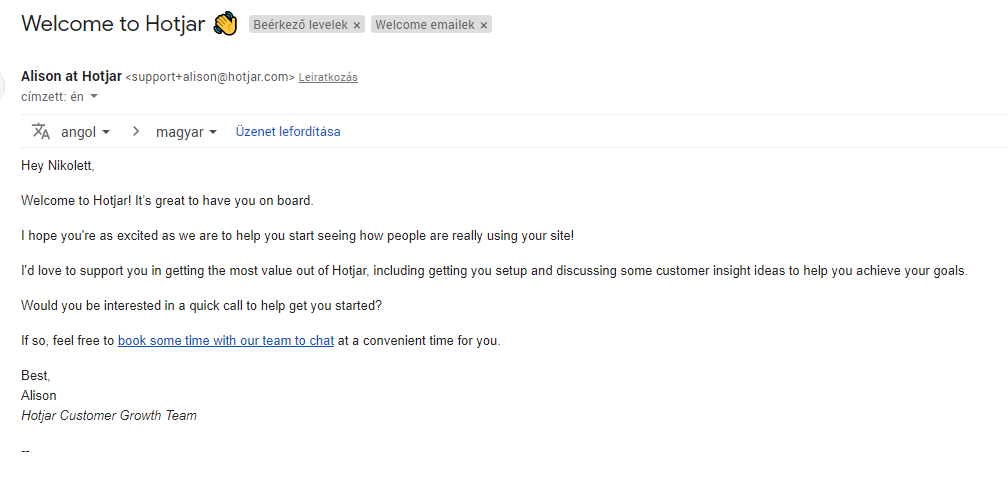
Here are a few great examples of simple, direct subject lines:
- Hotjar — “Welcome to Hotjar 👋”
- Happy Box — “Welcome to the Happy Box Fam”
- Lunya — “Customer account confirmation”
- My Rituals — “Welcome to My Rituals”
- Urban Outfitters — “Welcome! Here’s 10% off your next order”
- Airbnb — “How does Airbnb work?”
- Toluca Swim — “Welcome, Beauty | 10% off on us 🌿”
- Netflix — “New sign-in to your account”
- HubSpot — “Your HubSpot Receipt”
- Al Franken — “Yes, this is a fundraising email”
- Asana — “Welcome to Asana”
- Grammarly — “You+Grammarly = Ready for Action”
- AppSumo — “Receipt for Your Payment to AppSumo”
- PayPal — “Your business report for March 2020”
- HubSpot — “Our next steps”.
- Google Play — “Your Google Play Order Receipt from March 1, 2020”.
- Foundation — “Welcome aboard! 📈”
2. Newsletter subject lines
You’ll also want to keep it simple when you’re writing email subject lines for your newsletter.
Since your subscribers are used to getting your emails every week or two, they already have a clear understanding of what’s going to be in your email.
You don’t want to annoy your loyal newsletter readers with an overly long, complicated subject line—it’s best to keep it consistent and concise.
Here are a few examples of good email subject lines for newsletters:
- Etsy — “New week, new discoveries”
- Tim Ferriss — “5-Bullet Friday — March 6, 2020”
- G2 — “Introducing: Your New Learn Hub Newsletter”
- SeekingAlpha — “IPO Daily”
- Quora Digest — “Why are most Engineers not rich?”
- Office 365 — “Weekly digest: Office 365 changes”
3. Promotional subject lines
Email marketing is one of the best ways to promote a special season offer or a flash sale. When you’re writing a subject line for this type of email, get right to the point!
A busy reader wants to get a preview of the benefits they can expect from opening an email.
If you’re offering an exclusive deal to your users, mention the exact percentage discount you’re offering. If it’s the holidays and you’re offering a complimentary gift wrap, mention it in the subject line.
Another option for sales emails is to use a subject line that makes users curious about new products. The best example below is from Urban Outfitters, “psst….sooo much new stuff JUST dropped.”
The secretive tone and conversational words used in this subject line catch subscribers’ eyes and get them excited to see what new items are available.
Here are some examples of promotional subject lines:
- Gymshark — “The clothing you’ll sweat in 💦”
- ASOS — “25% off Every. Single. Style.”
- Urban Outfitters — “psst….sooo much new stuff JUST dropped”
- My Rituals — “Try our classic hand wash for $10!”
- Happy Box — “Shop Holiday Gifts Now, Ship ’em Later!”
- Warby Parker — “New frames to try!”
4. Funny email subject lines
Humor can be a powerful tool for creating standout subject lines, but it comes with a risk. If your joke doesn’t land, it can really turn your audience off (or even worse, offend them).
However, when your subject line does get a chuckle, it helps you stand out in a sea of boring emails.
Your brand voice, your industry, and your audience will dictate whether to use humor in your email subject lines.
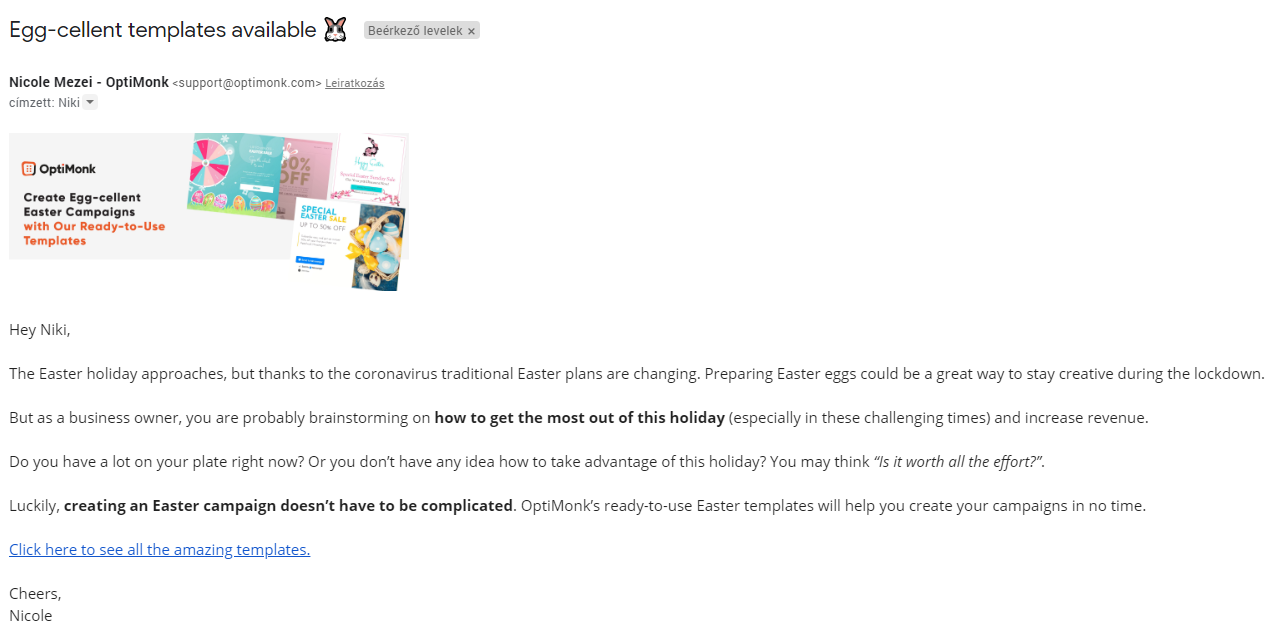
Here are some examples of funny subject lines:
- OptiMonk — “Egg-cellent templates available 🐰”
- Beauty Box — “Witches be crazy, and so is this box! 🎃”
- BabyBump — “Yes, I’m Pregnant. You Can Stop Staring At My Belly Now.”
- Happy Socks — “How d’ya like your socks in the morning? 🍳”
- Warby Parker — “Pairs nicely with spreadsheets”
- Sock Fancy — “You Doughn’t Want to Miss Out on This Pair! 🍪”
- HubSpot — “C’mon, it’s Friday and you’re killing time anyway.”
- Wool and the Gang — “Oh hey crochet! 👋”
- OpenTable — “Licking your phone never tasted so good”
- Johnny Cupcakes — “When life gives you cupcakes… ”
- HubSpot — “Dad jokes. I’ve got ‘em”
- Petco — “This email is littered with options”
- Groupon — “There are no deals in this email”
- UrbanDaddy — “You’ve Changed”
- DigitalMarketer — “This email is about email”
5. Controversial email subject lines
Even more risky than using humor is courting controversy. However, controversy can be an effective marketing and PR tool… if used wisely.
News, media, and digital publications often use controversial blog post headlines and subject lines because they’re effective at generating interest and boosting engagement.
Marketers can use the same formula to elicit a response from their audience and start a conversation with them.
Check out these examples of controversial email subject lines:
- Campaign Monitor — “Why your sales team sucks”
- Tim Ferriss — “Some Practical Thoughts on Suicide”
- 2060 Digital — “Why Your Current Digital Marketing Plan Stinks”
- Adobe — “Is Your Brand on Woo Woo?”
- Manicube — “*Don’t Open This Email*”.
- Dotmailer — “Let’s talk about cutting up your customers.”
- CopyMonk — “The death of email marketing.”
- GMass — “Most email marketers make this mistake”
- Ryan Levesque — “Seriously, Who DOES This?”
- LinkedIn — “Black Friday shoppers are the worst customers”
6. Single-word email subject lines
One-word email subject lines are not the norm, which means they can stand out in a recipient’s inbox and pique their interest. They’re useful for both sales outreach and follow-ups.
One of the most successful single-word email subject lines was Barack Obama’s “hey” email drip campaign during the 2012 Presidential campaign. Obama’s team raised more than $690 million from that email alone!
A word of caution—just because a single word subject line worked for Obama doesn’t mean it will work for you. We’d encourage you to A/B test these campaigns to see how they convert.
Here are a few more examples of single-word email subject lines:
- LeadFuze — “Partner?”
- HubSpot Sales Team — “Demo”
- Etsy — “Incoming!”
7. Email subject lines promoting lists
People love lists.
Wouldn’t you rather read a list compiled by someone else than do your own research? (You’re reading one now, after all.)
The ability to gain easy access to lots of useful information is why listicles are so popular among readers.
Lists are also a great way to build your credibility and reputation as a trusted source in your industry. Once you prove the value of your email newsletter, it’ll be easier to get your audience to engage with future emails.
Similarly, subject lines that use specific numbers (even when not related to a list) enjoy a high open rate because those numbers stand out and catch the eye.

These are some of the best email subject lines that feature lists and/or a specific number:
- Digital Marketer — “[READ] 47 Facebook Ad Examples…”
- Pinterest — “3 ways to improve your Pins”
- Digital Marketer — “2.3 Billion leads for $7”
- Neil Patel — “How I Drove 231,608 Visitors to My Site Using This New Channel”
- BuzzSumo — “What can 912 million blog posts teach us?”
- Brian Dean — “3 Case Studies”
- HubSpot — “Feast on these 10 campaigns for inspiration”
- Bonsai — “Top 0.1% invest in their personal brand”
- Ryan Robinson — “How I earned $24,616.56 blogging last month?”
- Johanna Wise — “10 Ways to Enjoy Your Career Transition”
- Kimanzi Constable — “14 publications that pay for content”
- Onnit — “Fix Your Posture with Our Top 5 Foam Roller Exercises”
8. Personalized email subject lines
According to a study by Adobe, 33% of marketers ranked personalization as their most important marketing strategy.
The use of personalized marketing has been growing steadily, and personalization is widely used in email marketing. It usually yields impressive results (26% higher open rates and a 14% increase in clickthrough rates).
Here are some examples of personalized email subject lines:
- ColourPop Cosmetics — “{Name}, you don’t want to miss this…”
- Etsy — “Hey {Name}, what will you discover?”
- My Rituals — “{Name}, still tossing and turning?”
- Frank and Oak — “{Name}, 🎁Here’s a gift to make your weekend even BETTER,”
- Flat Tummy Co — “😏{Name}, – ready to move a few stubborn LBS?! 😏”
- VoilaNorbert — “Hey {Name}, {Question}?”
- Grammarly — “You were epically productive last week!”
- TripAdvisor — “Welcome {Name}!Your {City} trip ideas are waiting…”
- Capterra — “What will you do with the extra day, {Name}!?”
- BrainFM — “ {Name}, here’s a code for 30% off Brain.fm!”
- Lyft — “ {Name}’s January with Lyft: X rides, milestones, and more!”
- LinkedIn Jobs — “ {Name}’: {Number} new jobs for ‘email marketing manager’ in New York City”
- Upwork — “ {Name}, clients are checking out your profile!’
- Bumble — “ {Name}, You have 2 New Bumble Notifications”
- VoilaNorbert — “ {Mutual contact name} from {Company name} Suggested I Reach Out to You”
- ActiveCampaign — “{Name}, your boss is shopping today too”
- RunKeeper — “Where do you rank, {Name}?”
- Netflix — “{Name}, we just added a TV show you might like”
- Netflix — “Top suggestions for {Name}”
9. Best email subject lines with questions
Questions provoke curiosity. They’re open ended, and readers are left craving the answer. If your subject line question is interesting, you have a good chance of boosting your open rates!
Personalizing your questions also increases engagement.
Each email subject line here includes a question:
- Salesforce — “How to grow your business faster in 15 minutes?”
- American Writers and Artists Institute — “Will this be your defining moment?”
- VoilaNorbert — “Feeling Overwhelmed? I can help!”
- Zillow — “What Can You Afford?”
- Netflix — “Netflix tonight?”
- ASOS — “15% off everything for ignoring us? 😉”
- Gymshark — “What makes everything better?”
- Sephora — “Rough Day?”
- Jeffrey Gitomer — “How Have You Progressed Since the 3rd Grade?”
- John Lee Dumas — “Are you coming?”
- Lunya — “Ready for our sleepover?”
- Jon Morrow — “Quick favor?”
- Backlinko — “Am I the only one with a bunch of questions?”
- Chris Brogan — “Are You Looking for a Better Way to Run Webinars?”
- MailShake — “Can you spare 5 minutes, {First name}?”
- Klenty — “Are you making these mistakes?”
10. Fear of Missing Out (FOMO) email subject lines
Most people don’t want to be left behind. That’s why FOMO is so effective in marketing campaigns.
Consider Black Friday. People will stand in line for hours just so they don’t miss the chance to get a great deal.
Urgency (limited time) and scarcity (limited availability) are practical techniques that work very well in marketing and sales email campaigns.

These email subject lines will increase the sense of FOMO your customers feel:
- T&C Summit — “⏰[Last Chance] Claim 109 Tactical Sessions”
- My Rituals — “Last Day! Winter Sale ends tonight ⏰”
- ASOS — “Last chance: +25% off sale 😯”
- Toluca Swim — “Have you grabbed yours yet?”
- (Miss Selfridge) — “Stop EVERYTHING! Up to 50% off ALL Dresses 🚨👗”
- Adobe Systems — “Ending soon: Save 40% on Creative Cloud”
- Hotwire Exclusive — “Members can rent a car for less today only!”
- PayPal – Theodore — “Last days! Enter for a chance to win a $10k getaway”
- H&M Fashion News — “Today only! 20% off basics”
- Instapage — “[LAST DAY] Save $600/year on Instapage”.
- JetBlue — “You’re missing out on points.”
- Digital Marketer — “[URGENT] You’ve got ONE DAY to watch this…”
- Guess — “Tonight only: A denim lover’s dream”
- BundleStars — “Pay $1.99 for a New Bundle of 6 STEAM Games (48 HOURS ONLY!)”
- VioletGrey — “Get Them Before They’re Gone…”
- Blinkist — “Last chance! Save on 4 months when you subscribe now”
- Beacon — “48 hours left: 1 year of Beacon Unlimited for free”
11. Best email subject lines that incite curiosity
Many TV shows use cliffhangers at the end of an episode to ensure that their audience is curious to see the next episode.
Curiosity-inducing subject lines are effective for the same reason. They grab readers’ attention and imagination, pushing them to open your email.
Here are a few examples of email subject lines that incite curiosity:
- The Iconic — “The sale’s on SALE! 😱”
- Gymshark — “The one you’ve been waiting for…”
- Etsy — “Our gift of the day is…”
- ASOS — “New styles added! 👀”
- Casper — “Fluff, yeah. Here’s our first September free gift offer”
- Dollar Shave Club — “Save money. Don’t leave the couch”
- West Elm — “💡 THIS SALE IS LIT 💡 20% off all lighting”
- TripAdvisor — “Guess what, {Name}?”
- GrubHub — “Last Day To See What This Mystery Email Is All About”
- Digital Marketer — “Is this the hottest career in marketing?”
- Beauty Bay — “Guess what Olivia Buckland is wearing? 👀🔥”
- Thrillist — “What They Eat In Prison”
- Tarte Cosmetics — “our NEW palette has ⭐⭐⭐⭐⭐”
- The Hustle — “A faster donkey”
- Refinery29 — “I got Botox — & THIS is what it looked like”
- Buzzfeed — “Not Cool, Guys”
- Thrillist — “DO NOT Commit These Instagram Atrocities”
- Buffer — “Buffer has been hacked – here is what’s going on”
- Quircky — “Abra-cord-abra! Yeah, we said it.”
- CrunchBase — “China Falls, Sleepy Unicorns, And The Deals Aren’t Bigger In Texas”
- Tim Ferriss — “The Most Interesting Man in the World is Back”
- NRDC — “Imagine America without national monuments”
5 email subject line best practices to increase your open rates
The average professional receives over 120 email messages a day, which means it’s challenging to capture their attention and get them to engage with your emails.
But the right subject line can help you break through the noise.
When you’re coming up with a subject line for an email, you need to find creative ways to incite a reader’s curiosity while also using the power of A/B testing and data to optimize each subject line you send out. That makes writing a great subject line both an art and a science.
1. A/B test your subject lines
Most Email Service Providers (ESPs) and Marketing Automation Platforms (MAPs) allow you to A/B test different versions of both subject lines and email content.
Often, even an experienced marketer won’t be able to predict whether an audience will respond better to one subject line or another.
Once you begin testing alternative subject lines, you’ll discover the promises and the pain points that resonate with your audience and get subscribers to click.
Some A/B testing software can leverage artificial intelligence (AI) to find and automatically choose the best-performing email subject line. Larger ecommerce stores should consider using this software to help them discover the best subject lines for their audience.

Image source: Zapier
2. Check your analytics page often
Most email marketing platforms offer extensive analytics on your email marketing performance, including open rates, clickthrough rates, URL clicks, and other stats.
Use this valuable data to continually optimize your email campaigns based on your audience.
You should also track important metrics like your return on advertising spend (ROAS) to stay on top of your performance goals.
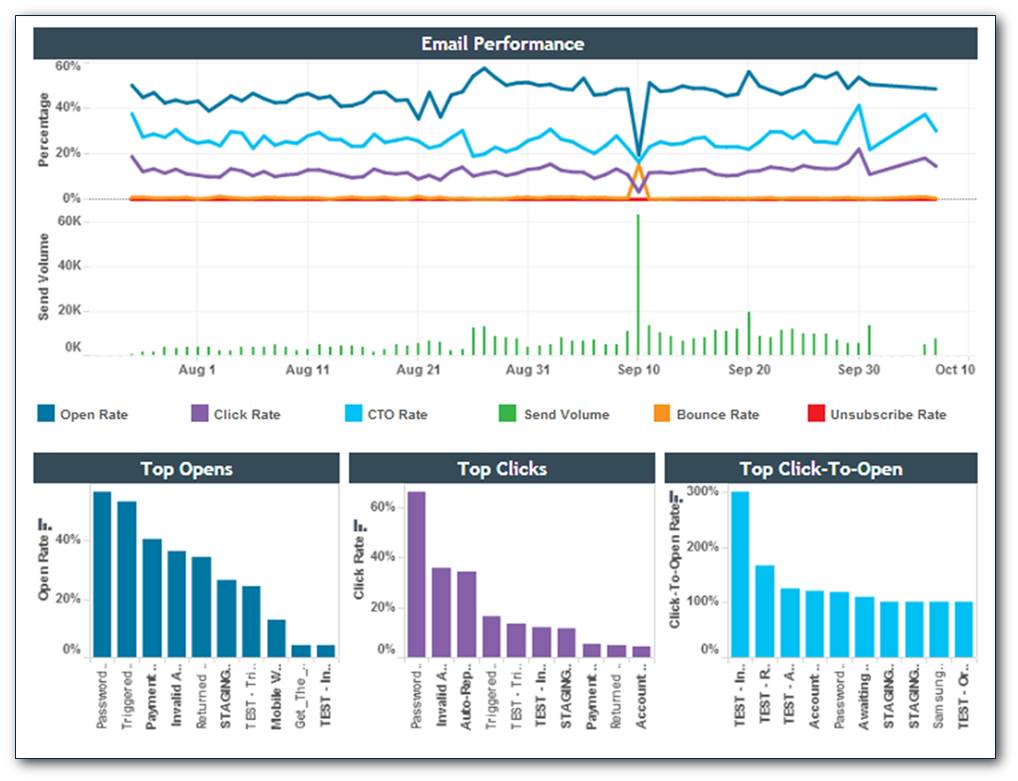
Image source: EmailVendorSelection
3. Optimize each subject line for mobile
According to EmailMonday, up to 61.9% of all email opens happen on mobile devices.
As more and more consumers use mobile devices for ecommerce purchases, this trend will only increase.

Image source: EmailMonday
The most common mobile email clients are iPhone and Gmail. These apps allow a subject line to have up to 70 characters before being cut off, which means you should go for a subject line length of anywhere between 41-70 characters.
Also, make sure to optimize the email preview text (the first line of the body of your email), since mobile users will see this on their screen before opening your email.
Some ESPs and MAPs also allow you to preview your email copy to see how it will be displayed on multiple devices before you send out the campaign. Take advantage of this feature and ensure that your outgoing email subject lines look great on all devices.
4. Use the email subject line length your customers respond to
Email subject lines can vary in length, as you’ve seen in our examples of great subject lines above.
Marketers often argue about what email subject line length works best, and you’ll see varying claims and studies.
One study by Validity found that longer subject lines (61-70 characters) had the highest open rates. Another study from HubSpot instead recommends shorter subject lines of less than 50 characters, especially for mobile devices.
Here’s our recommendation: A/B test different lengths of email subject lines to see what works best for your unique audience.
Bonus tip: Experiment with using emojis in your subject lines. Only 9% of email subject lines include emojis, but 56% of marketers and brands who started using emojis saw an increase in open rates.
5. Personalization and relevance
Personalization is the most proven tactic to increase your email engagement.
According to a study by CampaignMonitor, personalized subject lines can increase email open rates by 26% and clickthrough rates by 14%.
ESPs and MAPs usually allow you to use personalization (contact name, company name, etc.) in your email subject lines.
Using other forms of personalization such as send-time optimization and personalized offers can increase your transaction rates by over 600%.
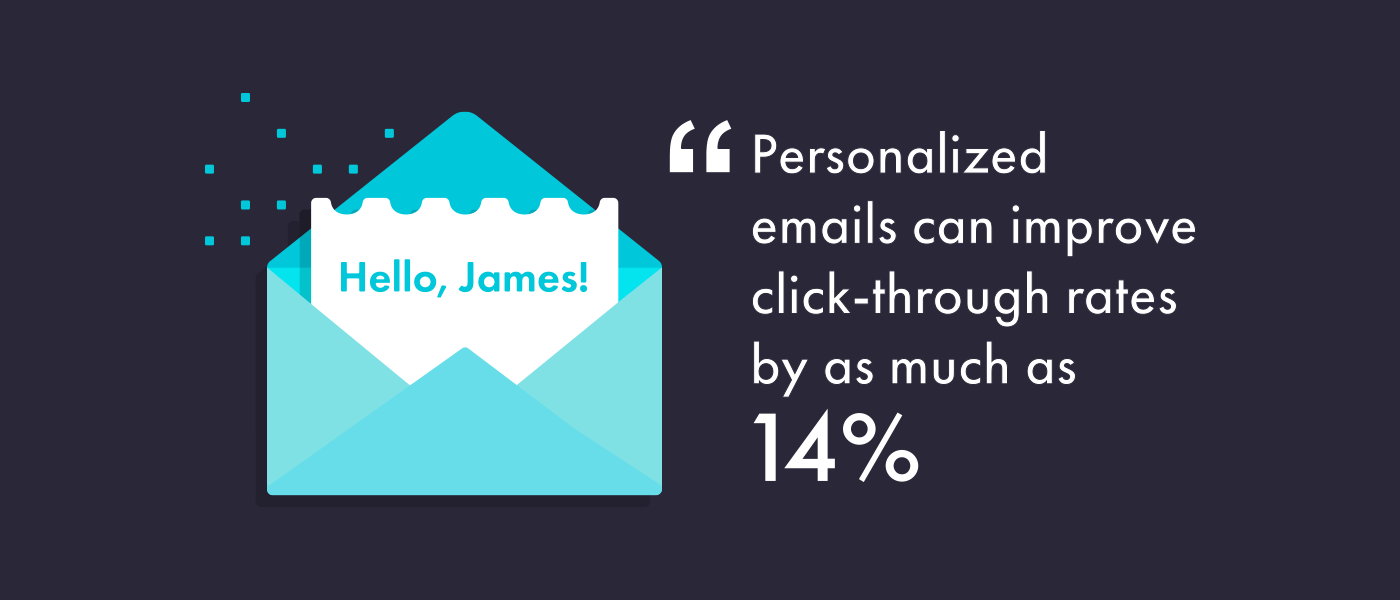
Image source: Mailigen
Most ESPs and MAPs also give you the option to collect information on your customers and users. You can use this information to segment your lists and send out personalized campaigns and offers.
4 biggest email subject line mistakes and how to avoid making them
Now that we’ve gone through some of the best practices for subject line writing, let’s look at some mistakes that can sabotage a great email subject line.
1. Avoid SPAM words
Avoiding your subscribers’ SPAM folders is imperative.
Your emails won’t get seen or opened if they never make it to your recipient’s main email inbox.
This is a growing problem for email marketers because email spam filters have become more aggressive in the last few years. More emails are now accidentally ending up caught in the net.
One surefire way to prevent your emails and campaigns from being lost in the abyss of spam folders is by not using SPAM trigger words in your subject line.
Here are some of the SPAM words you’ll want to avoid in your marketing email’s subject line:
- Clearance.
- Order.
- Earn $.
- Best price.
- Cheap.
- Fast cash.
- Incredible deal.
- No fees.
For a complete list of SPAM words that you should avoid putting in your subject lines, check out HubSpot’s The Ultimate List of Email SPAM Trigger Words.
2. Don’t use ALL CAPS
Your recipients don’t like being yelled at. Unfortunately, that’s exactly what it feels like if you use ALL CAPS in a subject line. And when someone feels like you’re yelling at them, they’ll most likely ignore your email.
In a study by the Radicati Group, 85% of respondents said they prefer lowercase subject lines.
A better subject line format is title case: capitalizing the first letter of every major word. Many marketers have found that using title case helps them capture attention without going overboard.
3. Don’t use the wrong personalization tokens
Most ESPs and MAPs allow you to use personalization tokens for your email campaigns.
However, it’s crucial to always ensure your database is clean, updated, and contains the correct information for each user.
Sending an email to a user that addresses them as “Hi {first.name}” or, even worse, uses the wrong name, makes you and your company look unprofessional.
It’s a guaranteed way to turn off the recipient and possibly cause a wave of unsubscribes.
4. Misleading subject lines
Your email subject line is similar to a blog headline—it should inform the recipient about the topic of the email.
They’re more likely to open and interact with an email if they know what they can expect to see inside.
But if you send an email subject line that’s misleading or clickbait-y, you’ll annoy people and make them mistrust the subject line of the next email you send. Worst-case scenario? They’ll unsubscribe altogether.
FAQ
What email subject lines get the most opens?
The best-performing subject lines are short, specific, and personal. Data shows that curiosity-driven, question-based, or benefit-oriented subject lines tend to get higher open rates.
How to write a killer subject line?
Here’s a quick 4-step formula for writing subject lines that convert:
- Be clear: Don’t confuse readers — clarity beats cleverness.
- Be concise: Aim for under 50 characters (especially on mobile).
- Add emotion or curiosity: Make people feel something.
- Test and refine: The best subject line is the one your audience proves works.
What are the 5 C’s of email?
The 5 C’s are a simple framework to ensure your emails (and subject lines) are effective:
- Clear: Readers should instantly understand what it’s about.
- Concise: Keep it short and scannable.
- Compelling: Give them a reason to open it.
- Credible: Avoid spammy words and exaggeration.
- Consistent: Align with your brand voice and previous emails.
Why do subject lines matter so much?
Because they’re your first impression. Over 45% of recipients decide whether to open an email based solely on the subject line. A good subject line can dramatically increase your open rates. And a weak one can bury your message forever.
Should I personalize my subject lines?
Absolutely. Personalized subject lines can boost open rates by up to 26%. You can include the recipient’s name, location, or past behavior (like viewed products). Just make sure your data is accurate. A broken {FirstName} token does more harm than good.
How long should my subject line be?
Most experts recommend 40–60 characters or 6–10 words. That’s short enough for mobile screens but long enough to communicate value. Run A/B tests to see what works for your audience.
Should I use emojis in subject lines?
Yes, if it fits your brand. Emojis can boost open rates and help your email stand out, but overdoing it looks unprofessional. Use 1 emoji max and only when it adds clarity or emotion (🎁, 💡, ❤️).
Wrapping up
All of the 140+ best email subject lines we’ve shared above have been used successfully by marketers and brands to drive higher open rates, increased clickthrough rates, and more conversions.
We hope you’ve found a few that you think will resonate well with your audience, and that you found our lists of best practices and common mistakes useful, too.
Share the best email subject lines you’ve seen (on or off the list) in the comments!
Migration has never been easier
We made switching a no-brainer with our free, white-glove onboarding service so you can get started in the blink of an eye.
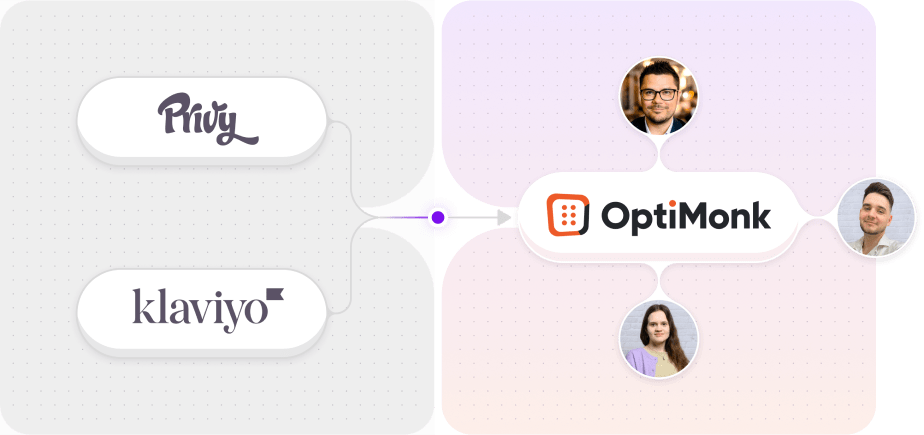
What should you do next?
Thanks for reading till the end. Here are 4 ways we can help you grow your business:
Boost conversions with proven use cases
Explore our Use Case Library, filled with actionable personalization examples and step-by-step guides to unlock your website's full potential. Check out Use Case Library
Create a free OptiMonk account
Create a free OptiMonk account and easily get started with popups and conversion rate optimization. Get OptiMonk free
Get advice from a CRO expert
Schedule a personalized discovery call with one of our experts to explore how OptiMonk can help you grow your business. Book a demo
Join our weekly newsletter
Real CRO insights & marketing tips. No fluff. Straight to your inbox. Subscribe now
Nikolett Lorincz
- Posted in
- Marketing
Partner with us
- © OptiMonk. All rights reserved!
- Terms of Use
- Privacy Policy
- Cookie Policy













